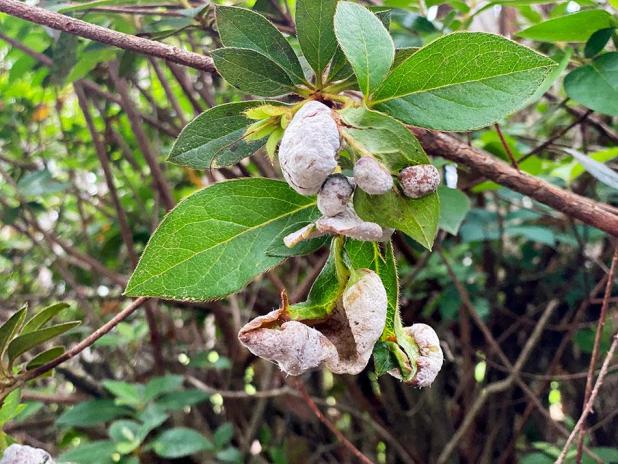
Leaf galls on azaleas are caused by a fungus.
—LSU AgCenter/Heather Kirk-Ballard
Get It Growing: What’s growing on my shrub?
Noticed some type of alien growth on your azaleas this spring? I’ve recently gotten phone calls for strange growths on azalea shrubs that were described by the caller as what looked like “cauliflower ear” — enlarged and puffy.
This condition is called leaf gall, and although they are unsightly and alien looking, these growths are not particularly serious.
Leaf gall can be common in Louisiana during early spring after extended periods of cool, wet weather. Two species of Exobasidium fungus cause this disease: one on azaleas and the other on camellias. Rhododendrons also can be affected, especially in spring.
The fungus infects plants and damages their leaves and stems, making them look thick and fleshy. It can sometimes be found on flowers and seeds, too. Symptoms typically appear soon after flowering on young, tender leaf and stem growth. The changes in texture and brown and white discoloration makes infected areas stand out against unaffected green leaves.
Affected leaves curl and turn from a pale green to white or pink. As time goes on, galls form and become covered with powdery, white spores, which is how the fungus spreads. The galls eventually turn brown and harden, and infected leaves fall off of plants. If not disposed of, infected, fallen leaves can lead to more diseased plants the following spring. The fungus also can survive within asymptomatic infected plant parts and as spores within the bud scales.
To manage this disease, it is best to use some good cultural practices such as increasing airflow between plants. Proper spacing when planting is important. Plants that are too close will spread the disease quickly. For established plantings, you can improve air movement by thinning out branches from the shrub. Thinning the canopy of the plant will promote the rate at which leaves dry out between rain events.
Frequent inspection of the plants and removal of infected leaves when they first appear are often all that is needed to control this disease. If large numbers of leaves are affected, prune the plants during late spring or early summer to remove infected leaves and stimulate new growth.
To remove the damaged leave, you want to cut out galled leaves a couple of inches below the symptoms and place infected leaves in plastic bags to prevent spreading of spores and discard them. It is especially important to rake up and destroy affected leaves that have fallen to the ground under the plants.
Preventative measures can be taken in late winter or early spring by applying fungicides such as triadimefon and others used to control petal and flower blights. Other chemical control may be necessary on azaleas. You can use products with the active ingredient mancozeb, or chlorothalonil fungicide sprays can be used according to label directions. Fungicides can give some control of leaf gall when they are applied beginning at bud break and repeated every 10 days as long as environmental conditions are suitable for disease — cool temperatures and high moisture.
Now that you know what that growth is, you can get into the garden and get it cleaned up. Pay attention to weather patterns in the future.
Our work in the garden is never finished, and the best gardens are those we check on often to tackle issues before they get out of hand. Don’t get caught with your plants down.
